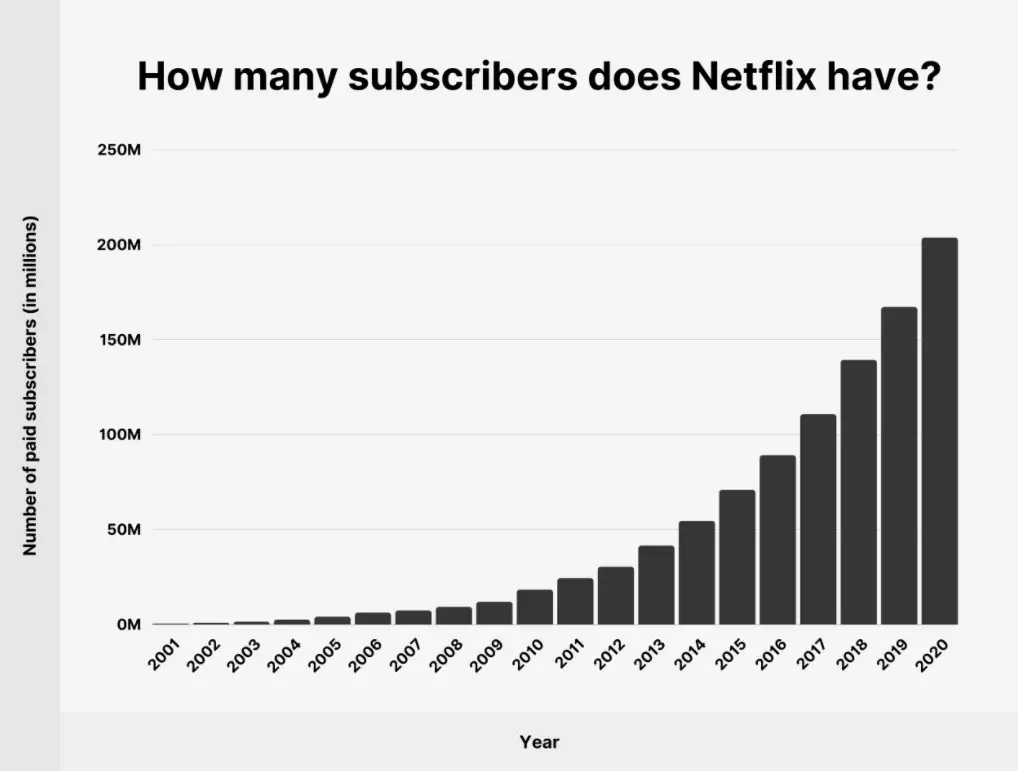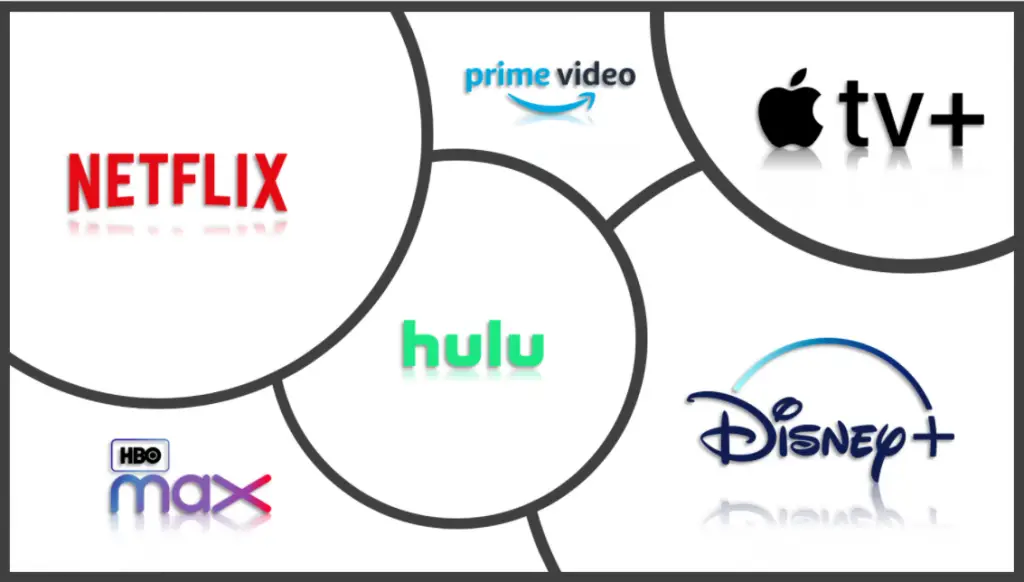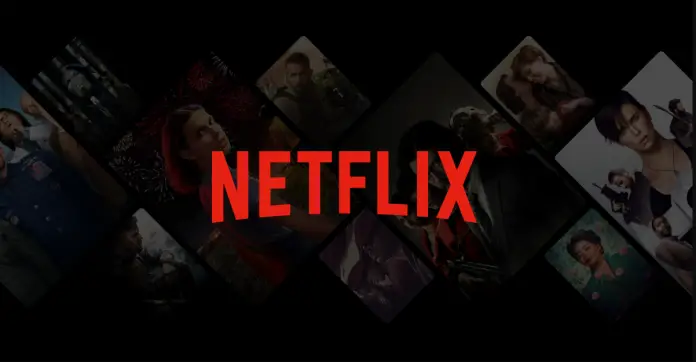Netflix was created in 1997 to rent and sell DVDs by mail order. You just choose a disc on the Web site and they send it to your home. Later, the company introduced a monthly subscription to unlimited DVD rentals.
By 2006, the company already had 5 million loyal customers. And in 2007, Netflix introduced its online movie theater, which changed the movie industry forever.
Not so long ago, in 2016, the company entered the market in 190 countries. And as of the end of 2019, it had 167 million subscribers. Netflix projects have several American Academy Awards and a huge number of Emmy Awards.

Of course, such a success could not go unnoticed. Big (and not so big) companies started to create their own services, and lately they have been appearing almost at the speed of sound. The loudest in recent times have been the launch of Apple TV+, Disney+, and the announcement of HBO Max and Peacock by NBCUniversal. They and Amazon Prime Video are now being called major competitors to Netflix.But are they really?

Disney+ broke ground with a $2.5 billion content budget and an entire library of Marvel, Lucas films and Disney movies, gaining 28 million subscribers in three months. HBO max plans to launch with a $1.5 billion to $2 billion a year content budget and a huge library of content already on the air. Amazon spent $6 billion for 2019 on exclusive content.
Those numbers seem huge until you realize that Netflix spent $15 billion on content in 2019 and plans to spend $17.5 billion in 2020.
But it’s not the huge investment that makes Netflix an unreachable player in the streaming services market. There are three main factors that have ensured this.
Netflix is the true IT-company
The head of Netflix, Reed Hastings, has repeatedly stated that they are first and foremost an IT company. What does that mean for the user? That everything will work as it should.
In terms of video quality, sound quality, stability, and user-friendliness, the company is way ahead of the curve. And in each area, we are constantly working – developing new compression algorithms, updating sound codecs, improving the interface, and implementing new features.
The main feature of Netflix is the recommendation system with the help of artificial intelligence. Its first drafts existed when the company was renting discs. Based on viewing history, retention, impressions of what you’ve watched (you can like or dislike it at the end), the service recommends content and writes about how much a particular movie or series is right for you.
No reviews or scores. No need to listen to other people’s opinions. Only what you like specifically, not someone else. From my experience: after two or three months of use, it works pretty accurately.
Disney+ and HBO MAX have another strong point – they are among the best in the world at creating content. And they have enough money to develop a good service. But they do not have the “user experience above all else” philosophy. And they are unlikely to reach the level of Netflix in this respect.
But there are IT companies in this market. Apple TV and Amazon Prime Video are services that can give the same level of user interaction as Netflix. But strangely enough, they are selling a different product.
Netflix offers only content
Today, Netflix has nothing but content. They don’t make money from selling devices, merchandise, or advertising. The customer pays for the content and gets the content. That’s it.
Amazon, for example, has a different goal. The main purpose of Amazon Prime Video is to keep you on Amazon’s site as long as possible and in that time, using targeting, sell you a product. Amazon isn’t selling content – it’s buying your time and attention for content. And you pay for it.
That doesn’t mean their content is bad. It’s just that it’s not designed as an end product, it’s designed as bait. And that’s what makes it different.
Apple, on the other hand, creates an ecosystem with all of its devices and services. And if you’re addicted to a show on Apple TV+, it’s almost impossible to watch it without Apple devices. Once you get used to using the service, swapping your iPhone, iPad, or MacBook for a competitor’s product becomes much more difficult. Just like with the Apple Watch, for example.
Apple’s main goal is to pull in and keep you in the ecosystem. Which, again, makes the content not the end product.
As stated earlier, Disney+ and HBO Max are different. Their product is content. But they are some of the biggest media companies in the world (HBO is owned by WarnerMedia Corporation). Which means that streaming service will never be their core business.
This could lead to these services being just an add-on to their core products. Like, for example, the expansion of the Star Wars and Marvel movie universes to include series on Disney+. It’s more like drawing attention to the main franchise projects than a stand-alone product.
In any case, Disney and HBO are far more experienced at creating content than Netflix. There’s no denying that. With the right vector, they can beat Netflix in this field.
But they also have different vectors.
Netflix invests in foreign content
Viewers outside the U.S. are beginning to get bored with the Hollywood product. They want something native and of high quality. And Americans began to learn little by little about the existence of foreign cinema, which is different from what is made in their country.
The general trend is understandable. But Netflix picked it up and developed it much earlier. Neither Disney, nor HBO, nor Apple are planning any foreign projects anytime soon. And when they do, it may be too late.
Netflix executives came to this much earlier. In 2013, the first series of Netflix’s own production, “House of Cards”, came out, and in 2015, the first non-English content from Netflix appeared – the Mexican series “Club de Cuervos” (“Club of Crows”).
The following year, when the company entered 190 countries, Netflix Original content in Brazilian, French and Spanish was released. In 2018, one billion dollars was invested in European-produced content, and up to 100 new non-English-language projects are scheduled to launch by the end of 2020.
Today, Netflix produces and buys international distribution rights in almost every country in the world: China, Hong Kong, Japan, South Korea, India, Turkey, France, Germany, Belgium, South Africa, Brazil, Spain, Mexico and others. Content from these countries is created by local people, Netflix almost does not interfere in the production.
Therefore, the projects do not lose their identity and are popular at home and internationally. A great example is “La Casa De Papel” (“Paper House”), Netflix’s most popular foreign project, whose third season was watched by 35 million accounts in a week.
So why Netflix may dominate
Netflix had the time advantage, and they took advantage of it perfectly. They practically created the online movie theater market and have been setting its direction for several years.
So far they are in a big gap, but the big corporations can quickly close the gap with an active infusion of funds. There is no doubt that Disney and HBO can create content better than Netflix, they have more experience in that. Especially with powerful exclusives, such as the acclaimed “Mandalorian” and a new episode of “Friends” with a classic cast. The only question that remains is the strategy and execution of the platform. If any of this goes wrong, they will never be a competitor to Netflix.






